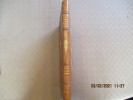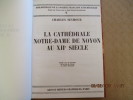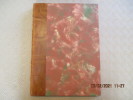-
Type
Book (30750)
Disk (1)
Engraving (1)
Magazine (1074)
Old papers (2)
Photographs (2)
Reprint (4)
-
Latest
Last 24h (27)
Last 3 days (11)
Last month (140)
Last week (1772)
-
Language
Chinese (1)
Dutch (40)
English (65)
French (31689)
German (16)
Italian (15)
Latin (4)
Portuguese (1)
Spanish (3)
-
Century
16th (3)
17th (14)
18th (60)
19th (1864)
20th (14724)
21st (1808)
-
Countries
Belgium (4033)
Brazil (1)
Canada (6)
China (15)
Côte d'Ivoire (79)
Denmark (486)
France (22988)
Greece (7)
Netherlands (1743)
Switzerland (2476)
-
Syndicate
ALAC (6)
CLAM (82)
ILAB (12092)
NVVA (1086)
SLACES (1086)
SLAM (10406)
SNCAO (71)
La bataille de Moscou - traduit de l'anglais par J. F. Gravand avec 6 cartes
in fine,Paris, Plon 1965, 225 pp., 1 vol. in 8 relié cartonnage et jaquette illustrée
Les trésors de Babylone.
Editions Princesse 1981 1 vol. relié in-4, cartonnage sous jaquette illustrée, 215 pp., nombreuses photos en couleurs, index. Bon état.
Het goud van Toetanchamon. Inleiding K. El Mallakh. Met 155 afbeeldingen in kleuren.
N.pl., Septuaginta, 1980.
207 p., illustrations. Hardbound 33 cm
LE TRESOR DE TOUTANKHAMON
PRINCESSE. 1980. In-Folio. Relié. Bon état, Couv. convenable, Dos satisfaisant, Intérieur frais. 207 pages augmentées de nombreuses photos en couleurs in et hors texte dont le 1er plat.. Avec Jaquette. . . Classification Dewey : 930.1-Archéologie
Préface de Kamal El MALLAKH. Classification Dewey : 930.1-Archéologie
LE TRESOR DE TOUTANKHAMON, LA TOMBE DE LA VALLEE DES ROIS
Princesse. 1980. In-4. Relié. Bon état, Couv. convenable, Dos satisfaisant, Intérieur frais. 207 pages. Illustré de nombreuses photos en couleur, dans et hors texte. Texte sur 2 colonnes. Grand In-4°. Annotation en page de titre.. Avec Jaquette. . . Classification Dewey : 930.1-Archéologie
Préface de Kamal El MALLAKH. Illutsré de 155 planches en couleurs. Classification Dewey : 930.1-Archéologie
Cilician Survey.
S.l.n.d. [c. 1955]. Grand in-8 broché, pp. 121-174, texte anglais, 6 cartes en noir.
Softcover, small stains on cover. Good condition. - Frais de port : -France 4,95 € -U.E. 9 € -Monde (z B : 15 €) (z C : 25 €)
Colonna Traiana
Turin, Einaudi, 1988 Hardcover with dustjacket in slipcase, 597 pages, 22 x 21 cm. ITALIAN TEXT * FINE ISBN 9788806598891.
Bound with slipcase Condition: in very good condition dust jacket. first edition. Essays Series, 716. Edited by Salvatore Settis. Photographs by Eugenio Monti. With 288 color illustrations and 92 figures in black and color. Publisher's cloth. Dust jacket
Philippi 1914-2014: 100 Years of French Research
Melissa Publishing House 2014 Ex-libris manus. au titre.
Très bon état d’occasion
Les Dieux d'Homère - Mythes et religions n°557
Presses universitaire de France 1966 in12. 1966. Broché.
couverture défraîchie bords frottés intérieur propre
Quelques points d'archéologie de l'Inde méridionale , présentés au Xie congrès des orientalistes en septembre 1897 à Paris
Ernest Leroux Malicorne sur Sarthe, 72, Pays de la Loire, France 1897 Book condition, Etat : Bon broché In-8 1 vol. - 22 pages
exemplaire non coupé
Geschichte im Bilde. Ein kulturgeschichtliches Bilderbuch für Schule und Haus. 5. völlig umgearbeitete und bedeutend vergrösserte Auflage. I. Teil: Von der Urzeit bis zum Ende der Antike. 382 Abbildungen mit Text.
Halle, Buchhandlung des Waisenhauses, 1928.
122 p., illustrations. Half cloth. 29.5 cm
A DICTIONARY OF CLASSICAL ANTIQUITIES ; mythology; religion; literature & art
1899 1899 LONDON SWAN SONNENSCHEIN 1899
IN4 toile ed;leg. défraichie,- 450 ill. 706p.texte à 2 colonnes. Remise de 20% pour toutes commandes supérieures à 200 €
La Cathédrale Notre-Dame de Noyon au XIIème siècle.
1975 Paris, Arts et métiers graphiques, 1975. In-4, 135 pages plus table des matières, texte sur deux colonnes. Reliure demi basane fauve, dos à quatre nerfs, fleuron et titre dorés. LXVIII planches en 34 feuillets hors-texte présentant 185 photos ou croquis et XII cartes. Ouvrage publié avec le concours de la ville de Noyon et d'Oise-Tourisme.
Bel exemplaire.
Essai sur les fouilles faites autour de la Maison-Carrée, pendant les années 1821 à 1822.
Nimes, chez l'auteur et chez le concierge de la Maison Carrée, 1824, 1 broché, couverture muette d'attente. in-8, belle lithographie sous serpente en frontispice dessinée par l'auteur et gravée par Augustin-François Lemaitre, 36 pages + trois lithographies dépliantes dont 1 en couleurs, dessinées par l'auteur et gravées par Charles Motte et in-fine 1 gravure en partie contrecollée sur la 3ème de couverture, dessinée par l'auteur et gravée par Eugène Gervais, exemplaire à pleines marges ;
Maison-Carrér, temple romain à Nimes.
Phone number : 06 80 15 77 01
Cachets d'archives publiques de quelques villes de la Syrie romaine
In-4 broché, Imprimerie catholique, Beyrouth, Extraits des Mélanges de l'Université Saint-Joseph, 1940, paginé 84-108, + 2 planches hors-texte. Un peu frotté et écorné, pliures, usure d'usage, exemplaire de lecture. Peu courant. Poids 60 g. Frais d'envoi 1,60 euro sur la France, 2 euros UE et Suisse, 2,50 euros pour le reste du monde (tarifs de base hors envois suivis).
Une statue cuirassée
Beyrouth, 1971 pp.11-12 + 2 planches hors-texte, extrait du "Bulletin du Musée de Beyrouth" t.XXIV, in-4, bel état
Actes du congrès de Pézenas. 25 - 28 mai 2006.
Marseille, SFECAG, 2006 Fort vol. in-4, broché, 704 p., nombreuses figures en noir dans le texte.
Couv. très légèrement usagée, sinon bonne condition. -
Dictateurs et dictatures de l'après-guerre
,Paris, Gallimard 1931, 264 pp., 1 vol. in 12 br. rousseurs à la couverture (pas à l'intérieur).
Barbarian Warriors: Saxons, Vikings, Normans
Brassey's (UK) Ltd 1997 In-4 relié 31,5 cm sur 21,3. 144 pages. Bon état d’occasion.
Bon état d’occasion
SHANKS HERSHEL & WITHERINGTON BEN III
Reference : RO20166836
(2004)
ISBN : 2895651515
LE FRERE DE JESUS - LE RECIT FASCINANT ET LA SIGNIFICATION DE LA PREMIERE DECOUVERTE ARCHEOLOGIQUE LIEE A JESUS ET SA FAMILLE
ADA INC. 2004. In-8. Broché. Etat d'usage, Plats abîmés, Dos abîmé, Intérieur frais. 290 pages - nombreuses photos, plans et illustrations en noir et blanc et en couleurs dans et hors texte - ex-dono sur la page de titre.. . . . Classification Dewey : 930.1-Archéologie
Classification Dewey : 930.1-Archéologie
L'aventure des manuscrits de la mer morte.
P., Le Seuil, 1996, in 8° broché, 371 pages.
PHOTOS sur DEMANDE. ...................... Photos sur demande ..........................


Phone number : 04 77 32 63 69
Guide documenté de Persépolis.
Téhéran, Safiran Publishing, 2012. 15 x 20, 247 pp., 192 illustrations en couleurs et en N/B, broché, couverture à très larges rabats, très bon état.
Traduction de Claude Cyrus Karbassi.
Mystères Celtes, une religion de l'insaisissable
SEUIL. 1975. In-4. Broché. Très bon état, Couv. fraîche, Dos impeccable, Intérieur frais. 96pp. Nbreuses illust et photog n&b et couleur sur planches dans le texte. . . . Classification Dewey : 930.1-Archéologie
Traduit de l'anglais par MF. de Paloméra. Classification Dewey : 930.1-Archéologie
Asiles d'aliénés politiques en Amérique et plus près de chez nous. Traduction originale par Augustin et Henriette Hamon.
,Paris, Editions Montaigne 1933, 123 pp., 1 vol. in 12 br.
 Write to the booksellers
Write to the booksellers









